NPS Inventory and Monitoring workshops in Hawaii
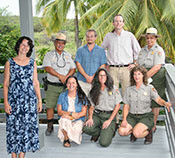 IAN staff recently started a new project with the National Park Service (NPS) at sites in the Pacific Region. Workshops were held with Inventory and Monitoring staff for the region as well as parks staff at the four west Hawaii parks: Pu`ukohola Heiau National Historic Site, Kaloko-Honokohau National Historic Park, Pu`uhonua o Honaunau National Historical Park, and Ala Kahakai National Historic Trail. The project will produce a poster for each park as well as a science newsletter, summarizing the cultural context for key natural resources within the parks as well as key threats, including abundant invasive species and impacts from rapid adjacent development.
IAN staff recently started a new project with the National Park Service (NPS) at sites in the Pacific Region. Workshops were held with Inventory and Monitoring staff for the region as well as parks staff at the four west Hawaii parks: Pu`ukohola Heiau National Historic Site, Kaloko-Honokohau National Historic Park, Pu`uhonua o Honaunau National Historical Park, and Ala Kahakai National Historic Trail. The project will produce a poster for each park as well as a science newsletter, summarizing the cultural context for key natural resources within the parks as well as key threats, including abundant invasive species and impacts from rapid adjacent development.
A cultural context for preserving Hawaii's diverse ecological landscape
 The historical link between native Hawaiian culture and the natural environment means that all natural resources (native species, water features, and landscapes) also have cultural significance. This inseparable connection underscores the importance of maintaining both the natural and spiritual values of west Hawai'i national parks. IAN staff, in collaboration with the Pacific Island Network of the National Park Service Inventory & Monitoring program, have published a newsletter for four parks on the island of Hawai'i. This communication tool will be used by the parks to engage the local community in the appreciation and protection of the unique cultural and natural features of these parks.
The historical link between native Hawaiian culture and the natural environment means that all natural resources (native species, water features, and landscapes) also have cultural significance. This inseparable connection underscores the importance of maintaining both the natural and spiritual values of west Hawai'i national parks. IAN staff, in collaboration with the Pacific Island Network of the National Park Service Inventory & Monitoring program, have published a newsletter for four parks on the island of Hawai'i. This communication tool will be used by the parks to engage the local community in the appreciation and protection of the unique cultural and natural features of these parks.
Managing the cultural and natural resources of the national parks of west Hawai'i island
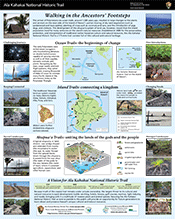 The historical link between native Hawaiian culture and the natural environment means that all natural resources (native species, water features, and landscapes) also have cultural significance. One example is the Ala Kahakai National Historic Trail, a 175-mile corridor that circumnavigates 3/4 of the island and encompasses many of the natural resources on the island of Hawai'i. Like other parks of west Hawai'i, it is a park that must manage both a cultural and natural heritage. IAN staff, in collaboration with the Pacific Island Network of the National Park Service Inventory & Monitoring program, created posters for each of the four parks of west Hawai'i, representing the resource features and current challenges facing their individual parks. The posters will be displayed in the parks to communicate this information to the public.
The historical link between native Hawaiian culture and the natural environment means that all natural resources (native species, water features, and landscapes) also have cultural significance. One example is the Ala Kahakai National Historic Trail, a 175-mile corridor that circumnavigates 3/4 of the island and encompasses many of the natural resources on the island of Hawai'i. Like other parks of west Hawai'i, it is a park that must manage both a cultural and natural heritage. IAN staff, in collaboration with the Pacific Island Network of the National Park Service Inventory & Monitoring program, created posters for each of the four parks of west Hawai'i, representing the resource features and current challenges facing their individual parks. The posters will be displayed in the parks to communicate this information to the public.
Resource Assessment and Science Communication with National Parks in Hawaii
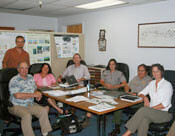 Continuing work with the National Parks of the Pacific Island Network, IAN staff Tim Carruthers and Jane Hawkey are currently in Hawaii working with three National Parks. At Kaloko-Honokohau National Historical Park on the big island of Hawai'i, a week-long workshop with park staff initiated a report to assess the current condition of natural marine, aquatic, and terrestrial resources within the park. A two-day workshop at Hawai'i Volcanoes National Park focused on developing brochures on invasive species for local and visitor audiences. Finally, at Kalaupapa National Historical Park on the island of Moloka'i, meetings with staff will develop syntheses of key natural resource features and threats for this unique region.
Continuing work with the National Parks of the Pacific Island Network, IAN staff Tim Carruthers and Jane Hawkey are currently in Hawaii working with three National Parks. At Kaloko-Honokohau National Historical Park on the big island of Hawai'i, a week-long workshop with park staff initiated a report to assess the current condition of natural marine, aquatic, and terrestrial resources within the park. A two-day workshop at Hawai'i Volcanoes National Park focused on developing brochures on invasive species for local and visitor audiences. Finally, at Kalaupapa National Historical Park on the island of Moloka'i, meetings with staff will develop syntheses of key natural resource features and threats for this unique region.
Engaging the public to help preserve the unique natural and cultural resources of two National Parks in Hawaii
 Following up from an August visit and series of on-site workshops run by IAN staff Tim Carruthers and Jane Hawkey, three science communication products have just been published for two Hawaiian parks in the National Park Service's (NPS) Pacific Island Network. For Hawai'i Volcanoes National Park (HAVO) on the big island of Hawai'i, two flyers target resident or off-island audiences in an effort to enlist their help in preventing the spread of invasive plants and animals, especially in areas yet to be overrun by these alien species. For Kalaupapa National Historical Park (KALA) on the island of Molokai, a poster designed for resident and off-island audiences features both the cultural and natural history of this remote peninsula, and highlights the unique native plants and animals found here that are currently challenged by invasive species, overfishing, pollution, and climate change.
Following up from an August visit and series of on-site workshops run by IAN staff Tim Carruthers and Jane Hawkey, three science communication products have just been published for two Hawaiian parks in the National Park Service's (NPS) Pacific Island Network. For Hawai'i Volcanoes National Park (HAVO) on the big island of Hawai'i, two flyers target resident or off-island audiences in an effort to enlist their help in preventing the spread of invasive plants and animals, especially in areas yet to be overrun by these alien species. For Kalaupapa National Historical Park (KALA) on the island of Molokai, a poster designed for resident and off-island audiences features both the cultural and natural history of this remote peninsula, and highlights the unique native plants and animals found here that are currently challenged by invasive species, overfishing, pollution, and climate change.
Communicating corals and climate change in the Pacific Islands
 Earlier this month IAN and COSEE Coastal Trends staff, in partnership with the National Park Service Pacific Island Network, launched the coral reef and climate change scientist-educator team. The team, based in Volcano, Hawai'i, will draw on the diverse skills and backgrounds of its members to create informative and engaging materials that communicate the unique features of coral reefs within the Pacific Island Network. Team members, from across the Pacific Islands of Hawai'i and American Samoa, represent the University of Hawai'i at Hilo, the Pacific Internship Programs for Exploring Science, and Kahuku High School. Over the course of six weeks, the team will design hands-on and virtual activities, create conceptual diagrams, and develop classroom lesson plans that draw on traditional knowledge and current NPS research.
Earlier this month IAN and COSEE Coastal Trends staff, in partnership with the National Park Service Pacific Island Network, launched the coral reef and climate change scientist-educator team. The team, based in Volcano, Hawai'i, will draw on the diverse skills and backgrounds of its members to create informative and engaging materials that communicate the unique features of coral reefs within the Pacific Island Network. Team members, from across the Pacific Islands of Hawai'i and American Samoa, represent the University of Hawai'i at Hilo, the Pacific Internship Programs for Exploring Science, and Kahuku High School. Over the course of six weeks, the team will design hands-on and virtual activities, create conceptual diagrams, and develop classroom lesson plans that draw on traditional knowledge and current NPS research.
Working with Pacific Island National Parks
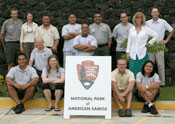 Tim Carruthers and Jane Hawkey from IAN recently continued work with the US National Park Service (NPS) Inventory and Monitoring program (I&M) in the Pacific Island Network (PACN) to develop communications products related to Park natural resources. Resulting products will be a two-page flyer summarizing some of the key features and cultural links with the National Park of American Samoa, a poster considering some of the marine natural resource considerations associated with the USS Arizona memorial at WWII Valor in the Pacific National Monument, and a two-page flyer summarizing groundwater processes and potential stressors surrounding Kaloko-Honokohau National Historical Park.
Tim Carruthers and Jane Hawkey from IAN recently continued work with the US National Park Service (NPS) Inventory and Monitoring program (I&M) in the Pacific Island Network (PACN) to develop communications products related to Park natural resources. Resulting products will be a two-page flyer summarizing some of the key features and cultural links with the National Park of American Samoa, a poster considering some of the marine natural resource considerations associated with the USS Arizona memorial at WWII Valor in the Pacific National Monument, and a two-page flyer summarizing groundwater processes and potential stressors surrounding Kaloko-Honokohau National Historical Park.
Communicating the cultural and ecological importance of coral reefs
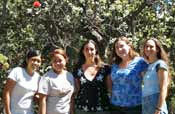 The COSEE Coastal Trends Coral Reef team has wrapped up the first phase of its project with the Pacific Island Network Inventory & Monitoring Program at the National Park Service. Their efforts culminated in a meeting with Park staff to review mock-ups of diagrams, games, activities, and videos created to help students learn about cultural and ecological importance of coral reefs in the Pacific Islands through inquiry and observation. Because it incorporates the ways in which the Hawaiian, Samoan, and Chamorro cultures are connected to corals, stewardship, and sustainability, this module will be unlike the others previously developed by Coastal Trends. The team is now working with web developer Adrian Jones to transform the mock-ups into interactive web pages.
The COSEE Coastal Trends Coral Reef team has wrapped up the first phase of its project with the Pacific Island Network Inventory & Monitoring Program at the National Park Service. Their efforts culminated in a meeting with Park staff to review mock-ups of diagrams, games, activities, and videos created to help students learn about cultural and ecological importance of coral reefs in the Pacific Islands through inquiry and observation. Because it incorporates the ways in which the Hawaiian, Samoan, and Chamorro cultures are connected to corals, stewardship, and sustainability, this module will be unlike the others previously developed by Coastal Trends. The team is now working with web developer Adrian Jones to transform the mock-ups into interactive web pages.
National Park of American Samoa: a place of spectacular beauty at our doorstep
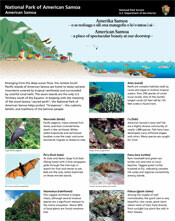 Tim Carruthers and Jane Hawkey from IAN spent a week with the National Park Service staff of the National Park of American Samoa to create this flyer. The purpose of this science communication tool is to convey the connection between the unique and fragile natural resources of American Samoa and the Samoan cultural practices and beliefs. The flyer will be distributed by the park to the Samoan community, church groups, and schools, as well as to off-island park visitors, to promote good stewardship and sustainable use of the natural resources found in these remote South Pacific islands.
Tim Carruthers and Jane Hawkey from IAN spent a week with the National Park Service staff of the National Park of American Samoa to create this flyer. The purpose of this science communication tool is to convey the connection between the unique and fragile natural resources of American Samoa and the Samoan cultural practices and beliefs. The flyer will be distributed by the park to the Samoan community, church groups, and schools, as well as to off-island park visitors, to promote good stewardship and sustainable use of the natural resources found in these remote South Pacific islands.
NPS Kaloko-Honokohau groundwater brochure
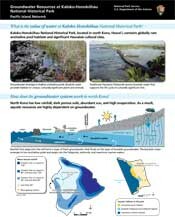 A collaboration between the National Park Service's Inventory and Monitoring Program, Kaloko-Honokohau National Historical Park, on the big island of Hawai'i, and IAN has produced this brochure intended for the informed audience of local land use planners and government officials, as well as informed park visitors. The focus is on the fragile natural and cultural resources such as anchialine pools, fishponds, and the nearshore marine areas that are reliant, to varying degrees, on the groundwater that filters through the park. Increasing withdrawal of groundwater by development wells upslope may cause changes to freshwater flow, with potential impacts upon these fragile ecosystems.
A collaboration between the National Park Service's Inventory and Monitoring Program, Kaloko-Honokohau National Historical Park, on the big island of Hawai'i, and IAN has produced this brochure intended for the informed audience of local land use planners and government officials, as well as informed park visitors. The focus is on the fragile natural and cultural resources such as anchialine pools, fishponds, and the nearshore marine areas that are reliant, to varying degrees, on the groundwater that filters through the park. Increasing withdrawal of groundwater by development wells upslope may cause changes to freshwater flow, with potential impacts upon these fragile ecosystems.
USS Arizona: once a site of human devastation, now a haven for marine life.
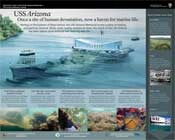 Tim Carruthers and Jane Hawkey spent a few days this past June with the National Park Service staff of the USS Arizona Memorial on Oahu, Hawaii, to create this poster. Designed for both the general public and school audiences, it provides a unique perspective on the historic WWII ship—one of a bounty of marine life that have made the sunken wreck their home. Modern environmental challenges face Pearl Harbor, the lagoon where the USS Arizona rests, such as sedimentation, pollution, and invasive species.
Tim Carruthers and Jane Hawkey spent a few days this past June with the National Park Service staff of the USS Arizona Memorial on Oahu, Hawaii, to create this poster. Designed for both the general public and school audiences, it provides a unique perspective on the historic WWII ship—one of a bounty of marine life that have made the sunken wreck their home. Modern environmental challenges face Pearl Harbor, the lagoon where the USS Arizona rests, such as sedimentation, pollution, and invasive species.
War in the Pacific National Historical Park brochure
 This 6-panel park brochure is the result of an IAN collaboration with the managers and staff of the War in the Pacific National Historical Park on Guam. It highlights for the park visitor the connection between the unique natural ecosystems and species, and the cultural and war history of the island. The goal of the brochure is to educate both the local and off-island park visitor, and instill stewardship of these fragile resources for future generations to enjoy.
This 6-panel park brochure is the result of an IAN collaboration with the managers and staff of the War in the Pacific National Historical Park on Guam. It highlights for the park visitor the connection between the unique natural ecosystems and species, and the cultural and war history of the island. The goal of the brochure is to educate both the local and off-island park visitor, and instill stewardship of these fragile resources for future generations to enjoy.
9th Pacific Islands Conference on Nature Conservation and Protected Areas
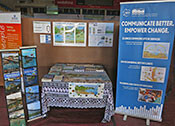 IAN staff attended the 9th Pacific Islands Conference on Nature Conservation and Protected Areas in Fiji in early December, setting up our first IAN conference booth. Our booth proved extremely popular, with almost all of our materials ravaged by the end of the first day! The conference itself was a fantastic opportunity to meet Pacific-based colleagues that we've worked with virtually, and to catch up with others. IAN diagrams and reports were featured in several keynote presentations and workshops throughout the conference, and we've started lining up potential new collaborations for the next few years. The word is getting out!
IAN staff attended the 9th Pacific Islands Conference on Nature Conservation and Protected Areas in Fiji in early December, setting up our first IAN conference booth. Our booth proved extremely popular, with almost all of our materials ravaged by the end of the first day! The conference itself was a fantastic opportunity to meet Pacific-based colleagues that we've worked with virtually, and to catch up with others. IAN diagrams and reports were featured in several keynote presentations and workshops throughout the conference, and we've started lining up potential new collaborations for the next few years. The word is getting out!